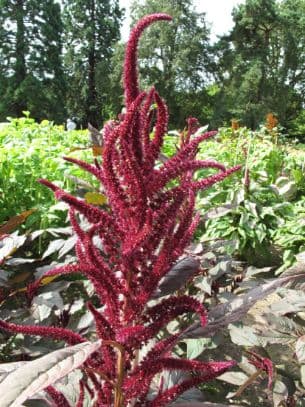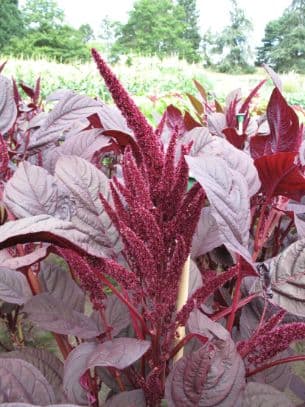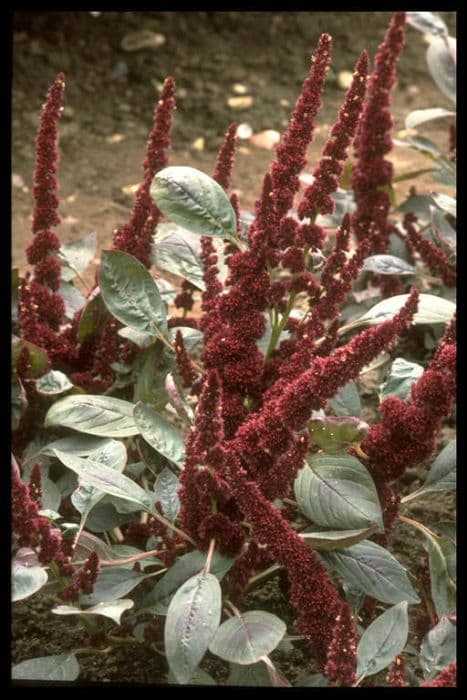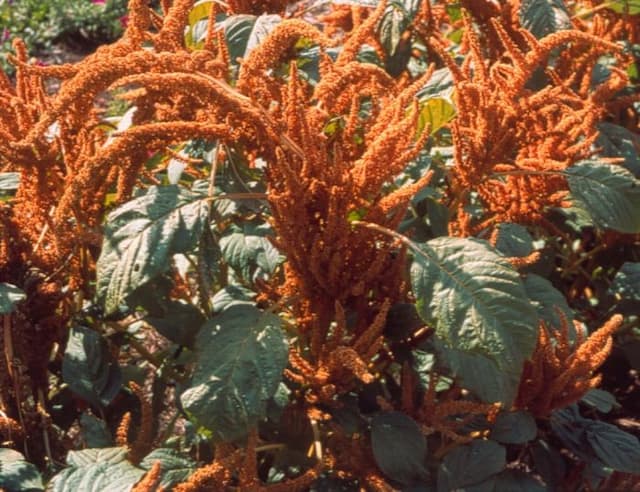Golden amaranth Amaranthus cruentus 'Golden Giant'

ABOUT
The Golden Giant is a vibrant and showy annual plant known for its ornamental and edible qualities. Its hallmark is the eye-catching golden-yellow to orange flowers that form dense, feathery plumes towering above the foliage. The flowers are composed of tiny, densely packed blooms that create a fluffy texture, which makes them a favorite in cut flower arrangements and as a backdrop in garden landscapes. The leaves of this variety are equally attractive, exhibiting a green to reddish hue that contrasts beautifully with the bright flower spikes. These leaves are broad and somewhat lance-shaped, often with a slightly wavy or crinkled texture, which adds visual interest. The stems are sturdy and can also show hints of red or purple, which complements the overall color scheme of the plant. The Golden Giant is not only prized for its ornamental use but also harvested for its nutritious seeds, which are tiny, round, and can range from a light cream to a golden color. These seeds are commonly known as an ancient grain and used in a variety of culinary applications due to their high protein content and nutty flavor. Overall, the plant has a bushy and upright growth habit, presenting a striking and regal appearance that can enhance any garden setting.
About this plant
 Names
NamesFamily
Amaranthaceae
Synonyms
Golden Giant Amaranth, Red Amaranth, Mexican Grain Amaranth, Large Grain Amaranth, Blood Amaranth, Velvet Flower, Prince's Feather, Purple Amaranth
Common names
Amaranthus hybridus var. cruentus, Amaranthus paniculatus.
 Toxicity
ToxicityTo humans
Amaranth, including the 'Golden Giant' variety, is not known to be toxic to humans. In fact, many parts of the plant are edible and are consumed around the world. The leaves, stems, and seeds of amaranth are often used in a variety of dishes. There is no known toxicity or adverse consequences associated with ingesting the plant when it is properly prepared and cooked.
To pets
Amaranth is also not known to be toxic to pets. It doesn't contain any known toxins that could cause harm to animals if ingested. Consequently, pets that consume parts of the amaranth plant generally do not exhibit poisoning symptoms, and there are no significant adverse consequences reported. However, as with any non-traditional pet food, moderation is key, and introducing any new food into your pet's diet should be done carefully to monitor for any potential allergic reactions or digestive issues.
 Characteristics
CharacteristicsLife cycle
Annuals
Foliage type
Deciduous
Color of leaves
Green
Flower color
Red
Height
4 feet (1.22 meters)
Spread
2 feet (0.61 meters)
Plant type
Herb
Hardiness zones
2
Native area
Americas
Benefits
 General Benefits
General Benefits- Nutritional value - Golden Giant Amaranth is high in protein, essential amino acids, and is a source of dietary fiber, vitamins, and minerals like iron and magnesium.
- Edible parts - Both the leaves and seeds of Golden Giant Amaranth are edible, with leaves used for salads or cooked like spinach and seeds that can be ground into flour or popped like popcorn.
- Drought tolerance - Golden Giant Amaranth is tolerant of arid conditions, making it suitable for growth in areas with water scarcity.
- Easy cultivation - It is generally easy to grow and doesn't require a lot of maintenance, making it accessible for beginner gardeners.
- Soil adaptability - Golden Giant Amaranth can grow in a variety of soil conditions, from loam to sandy soils, albeit with a preference for well-drained soils.
- Attracts pollinators - The plant's flowers attract beneficial insects, such as bees, which are vital for pollinating plants.
- Gluten-free - The seeds of the Golden Giant Amaranth offer a gluten-free grain alternative for those with gluten sensitivities or celiac disease.
- Ornamental use - The striking appearance of the tall plants and their golden grain heads make them a visually appealing addition to gardens.
- Fast growing - Golden Giant Amaranth plants have a relatively quick growth cycle, allowing for faster harvesting times.
- Cultural significance - Amaranth has historical importance in several cultures and is still celebrated in various traditional recipes and ceremonies.
 Medical Properties
Medical Properties- Antioxidant properties: Amaranthus cruentus contains compounds like flavonoids and phenolics, which have antioxidant effects.
- Anti-inflammatory effects: Some studies suggest that the plant has anti-inflammatory properties that can help reduce inflammation in the body.
- Nutritional supplementation: The plant is rich in vitamins (A, C and folate) and minerals (calcium, magnesium, and iron), which are important for maintaining good health.
- Antidiabetic potential: There is evidence to suggest that Amaranthus cruentus may help in regulating blood sugar levels, offering potential antidiabetic benefits.
 Air-purifying Qualities
Air-purifying QualitiesThis plant is not specifically known for air purifying qualities.
 Other Uses
Other Uses- Amaranthus cruentus 'Golden Giant', also known simply as amaranth, can be used as a natural dye, with various parts of the plant providing colors for textiles and other materials.
- The plant's tall and vibrant flower spikes can be used in floral arrangements and as decorative elements in gardens or events.
- Amaranth's strong stems can be woven into biodegradable garden ties or support structures for climbing plants.
- The seed husks, which are often a byproduct of harvesting, can be used in the creation of sustainable packing materials.
- Golden Giant amaranth's dried stalks may be utilized as fuel in biomass stoves and boilers, offering a renewable energy source.
- This amaranth variety can be used in crafting activities, specifically in making natural crowns or wreaths due to its sturdy and attractive foliage.
- The seeds of amaranth are often used as bird feed, especially appealing to finches and other small birds that prefer small-sized grains.
- When intercropped with other plants, amaranth can serve as a living mulch, providing ground cover and helping to regulate soil temperature and moisture levels.
- Leaves and stems of the plant can be used to produce a green pigment for use in art supplies, like natural watercolor paints.
- Amaranth flowers can also be incorporated into craft paper making for a textured and visually interesting paper product.
Interesting Facts
 Feng Shui
Feng ShuiThe Amaranth is not used in Feng Shui practice.
 Zodiac Sign Compitability
Zodiac Sign CompitabilityThe Amaranth is not used in astrology practice.
 Plant Symbolism
Plant Symbolism- Immortality: The name Amaranthus is derived from the Greek word 'amarantos' which means "unfading." This is a reference to the flowers which maintain their color even after drying out.
- Unconquerable: Due to its hardy nature and ability to grow in challenging conditions, Amaranthus symbolizes an unconquerable spirit and resilience.
- Invisibility: In mythology, Amaranthus was woven into a crown for a Greek god and was said to render him invisible. Thus, it can symbolize protection and invisibility.
- Heart health: 'Golden Giant' is also known for its nutritious seeds which are associated with heart health, representing nurturance and life sustenance.
 Water
WaterGolden Giant Amaranth thrives when watered deeply once a week, providing about an inch of water each time, which equates to roughly 0.623 gallons per square foot. It's important to allow the soil to slightly dry out between waterings to avoid waterlogging. In hotter and drier climates, it may require more frequent watering to maintain moist soil, especially during peak summer heat. The best method is to water at the base of the plant to keep foliage dry and prevent fungal diseases. During the cooler months, water less frequently as the plant's water needs decrease.
 Light
LightGolden Giant Amaranth prefers a full sun location where it can receive at least 6 to 8 hours of direct sunlight each day. Position the plant in a spot that is free from too much shade to ensure vigorous growth and optimal foliage color. Although it can tolerate partial shade, it thrives best and produces the most abundant seeds in a sunny spot.
 Temperature
TemperatureGolden Giant Amaranth is a warm-weather plant that prefers temperatures between 65°F and 80°F. It can withstand minimum temperatures down to around 50°F, but growth will be stunted below this range. The maximum temperature it can endure is approximately 95°F, beyond which the plant might experience stress.
 Pruning
PruningPruning Golden Giant Amaranth is generally done to encourage bushier growth and prevent it from becoming top-heavy. It's best to trim the plant in the early stages, when it's about 6-8 inches tall, by pinching off the top leaves. Prune periodically throughout the growing season to promote a fuller plant. The optimal time for pruning is the late spring through summer.
 Cleaning
CleaningAs needed
 Soil
SoilGolden Giant Amaranth thrives in a well-draining soil mix with a good amount of organic matter. A mix of loam, compost, and sand would be ideal, targeting a pH level between 6.0 and 7.5 for optimal growth.
 Repotting
RepottingGolden Giant Amaranth typically does not need frequent repotting as it is often grown as an annual plant. However, if growth is inhibited by container size, it can be repotted in the spring.
 Humidity & Misting
Humidity & MistingGolden Giant Amaranth is tolerant of a wide range of humidity levels but prefers moderate humidity. It does not require any special humidity adjustments when grown outdoors.
 Suitable locations
Suitable locationsIndoor
Place in full light, water when topsoil feels dry.
Outdoor
Full sun, well-draining soil, water regularly.
Hardiness zone
2-11 USDA
 Life cycle
Life cycleAmaranthus cruentus 'Golden Giant', commonly known as Golden Giant Amaranth, begins its life cycle when seeds are sown after the last frost in warm, well-drained soil. Germination occurs within 7-10 days, and the seedlings emerge, soon developing true leaves alongside the initial cotyledons. The vegetative stage follows, where the plant grows rapidly, producing a robust stem and a bushy structure with large, colorful foliage. As the plant matures, it enters the flowering stage, producing tall, showy flower spikes that can range in color from golden-yellow to reddish tones. During this phase, pollination occurs, which can be facilitated by both wind and insects, leading to the production of seeds contained within the flower heads. Finally, upon maturation, the seeds can be collected for future planting, and the plant will naturally deteriorate if left unharvested, completing its annual life cycle.
 Propogation
PropogationPropogation time
Spring to early summer
The most popular method for propagating Golden Giant Amaranth is by seed. Seed propagation can be initiated indoors 4-6 weeks before the last frost date for early starts, or they can be sown directly into the garden soil after the danger of frost has passed. When sowing indoors, use shallow trays filled with a well-draining seed starting mix, planting the seeds at a depth of around 1/4 inch (6mm). It is crucial to maintain even moisture until germination, which typically occurs within 7-10 days. Seedlings can be thinned or transplanted into individual pots once they've developed a couple of true leaves and are strong enough to handle. Ensure that the soil temperature for germination is around 70°F (21°C). After all risk of frost is over and seedlings are sufficiently hardened off, they can be transplanted outside into a sunny location with well-draining soil.









